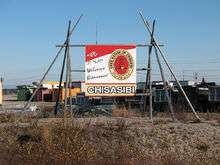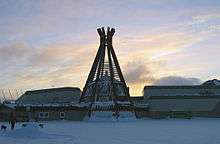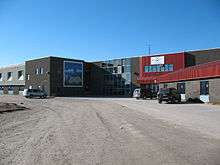Chisasibi
Chisasibi (Cree: ᒋᓵᓰᐲ/Cisâsîpî meaning Great River) is a village on the eastern shore of James Bay, in the Eeyou Istchee equivalent territory (ET) in northern Quebec, Canada. It is situated on the south shore of La Grande River (the Grand River), less than 10 km (6.2 mi) from the river's mouth. Chisasibi is one of nine Cree villages in the region, and is a member of the Grand Council of the Crees of Quebec.[2] The territory surrounding Chisasibi is part of the Eeyou Istchee James Bay Territory, of which parts are jointly managed by the municipalities of the Jamésie TE and the Cree Regional Authority of the Eeyou Istchee TE.[3]
Chisasibi ᒋᓵᓰᐲ | |
|---|---|
| Cree Nation of Chisasibi | |
 | |
 Chisasibi Chisasibi (on the La Grande River, below Longue Pointe) | |
| Coordinates: 53°47′00.00″N 78°53′45.00″W | |
| Country | Canada |
| Province | Quebec |
| Region | Nord-du-Québec |
| TE | Eeyou Istchee |
| Established | 1980 |
| Government | |
| • Type | Cree reserved land |
| • Chief | Davey Bobbish |
| Area | |
| • Land | 828.18 km2 (319.76 sq mi) |
| Population (2016)[1] | |
| • Total | 4,872 |
| • Density | 5.9/km2 (15/sq mi) |
| Time zone | UTC−05:00 (EST) |
| • Summer (DST) | UTC−04:00 (EDT) |
| Postal Code | J0M 1E0 |
| Area code(s) | 819 |
| Website | chisasibi.ca |
The surface area of the town is 491.63 km2 (189.82 sq mi). The surface area of associated Chisasibi Cree village municipality is 828.18 km2 (319.76 sq mi).[1]
History
The Cree have lived in the region for many centuries but were nomadic. In 1803, the Hudson's Bay Company founded Fort George, a trading post on the north shore which was relocated to the largest island in the mouth of La Grande River in 1837. Fort George became a permanent village as the local Cree population abandoned their nomadic way of life in the early 20th century and settled nearby. In 1940, its population was about 750 and grew to almost 2,000 in 1980.[4]
In the mid 1970s, the construction of the James Bay hydro-electric project began, diverting upstream rivers into La Grande watershed, increasing its flow significantly, resulting in erosion of Fort George Island (also called Governor's Island) and disruption to the formation of a solid ice cover in winter.[5] In response, the Quebec Government built a new community on the mainland's south shore, relocating the population and some 200 houses to the new site in 1981. The village was renamed Chisasibi (official name: Cree Nation of Chisasibi). At the same time, the Fort George Relocation Corporation was formed to oversee the relocation.[2][4]
The Cree Nation of Chisasibi

Chisasibi is the most northern Cree village accessible by road, and the northernmost community with year-round road access in eastern North America. A 90 km (56 mi) paved road, running from Radisson, and parallel to the Grand River, connects Chisasibi to the James Bay Road (French: Route de la Baie James).[3] The James Bay Road (formerly part of Route 109) was built from 1971 to 1974 as part of the James Bay hydroelectric project and connects Matagami to Radisson. Chisasibi Airport is located just west of the village and Air Creebec operates scheduled service from this airport. Though this is the most northern village, this is not where the road ends. From LG-1 (La Grande-1 generating station), the road continues north to a location called Longue Pointe (Long Point). It is the farthest one can go by road east of the Hudson Bay.
Many Cree in Chisasibi engage in hunting, trapping, and fishing activities but all catch is meant for local consumption. Other economic activity includes local services (health care and education), employment by Hydro-Québec and some hospitality services. An elected Chief and Council help administer the Cree Nation of Chisasibi Office.
Other Cree villages near Chisasibi are Whapmagoostui, 200 km (120 mi) to the north in Nunavik, on the eastern shore of Hudson Bay near the Northern village of Kuujjuarapik, and Wemindji, about 100 km (62 mi) to the south.
Demographics
The population of Chisasibi comprises approximately 4,000 Cree, about 250 Inuit, and 300 non-native people.[6] Statistics Canada's 2011 Census shows a total population of 4,484. 2006 Census shows the median age of the population is 24.1 years old, the percentage of the population aged 15 and over is 66.2, and the total number of census families was 960.[7][8]
| Year | Pop. | ±% |
|---|---|---|
| 1991 | 2,306 | — |
| 1996 | 3,251 | +41.0% |
| 2001 | 3,467 | +6.6% |
| 2006 | 3,972 | +14.6% |
| 2011 | 4,484 | +12.9% |
| 2016 | 4,872 | +8.7% |
| Source: Statistics Canada Community Profiles | ||
Total private dwellings (excluding seasonal cottages): 788 (total: 885)
Languages
Cree and Inuit are spoken as the first language in Chisasibi, in addition to English, as a primary language for official dealings.[9] Only 7.8% of the residents of Chisasibi speak one or both of the official languages as a mother tongue.[10] There has been criticism of the Quebec language policy with respect to native languages, particularly Cree, many related to Hydro-Québec's hydroelectric dam project in the James Bay region.
Mother tongues:[11]
- Other as first language (predominantly Cree): 92%
- English as first language: 4%
- French as first language: 3.5%
- English and French as first language:<1 %
Education

The Cree School Board operates Waapinichikush Elementary School and the James Bay Eeyou School (JBES; French: École Eeyou De La Baie James; Cree: ᒉᐃᒥᔅ ᐯᐃ ᐄᔨᔨᐤ ᒋᔅᑯᑎᒫᒑᐅᑭᒥᒄ), a high school. Eeyou opened in 1980.[12] Previously the school provided boarding services for high school students for students from other villages of the James Bay region: Eastmain, Whapmagoostui, and Wemindji as at the time all high school classes in the region were in Chisasibi.[13] As of 2017 Eeyou has 398 students.[12]
Climate
Chisasibi has a subarctic climate (Köppen Dfc), typical of the central latitudes of Quebec, with very cold and snowy winters and mild, rainy summers.
| Climate data for Chisasibi, Quebec (1915-1969) | |||||||||||||
|---|---|---|---|---|---|---|---|---|---|---|---|---|---|
| Month | Jan | Feb | Mar | Apr | May | Jun | Jul | Aug | Sep | Oct | Nov | Dec | Year |
| Average high °C (°F) | −17.5 (0.5) |
−15.6 (3.9) |
−9.1 (15.6) |
−0.1 (31.8) |
7.1 (44.8) |
14.1 (57.4) |
17.4 (63.3) |
15.9 (60.6) |
11.7 (53.1) |
5.5 (41.9) |
−1.8 (28.8) |
−10.8 (12.6) |
0.6 (33.1) |
| Daily mean °C (°F) | −23.3 (−9.9) |
−22.0 (−7.6) |
−15.8 (3.6) |
−5.7 (21.7) |
2.3 (36.1) |
8.8 (47.8) |
12.3 (54.1) |
11.5 (52.7) |
7.9 (46.2) |
2.5 (36.5) |
−4.8 (23.4) |
−15.2 (4.6) |
−4.3 (24.3) |
| Average low °C (°F) | −29.0 (−20.2) |
−28.2 (−18.8) |
−22.4 (−8.3) |
−11.0 (12.2) |
−2.6 (27.3) |
3.3 (37.9) |
7.1 (44.8) |
7.1 (44.8) |
4.2 (39.6) |
−0.3 (31.5) |
−7.7 (18.1) |
−19.6 (−3.3) |
−9.2 (15.4) |
| Average precipitation mm (inches) | 25.1 (0.99) |
21.4 (0.84) |
26.0 (1.02) |
20.7 (0.81) |
32.7 (1.29) |
45.7 (1.80) |
77.3 (3.04) |
66.2 (2.61) |
64.9 (2.56) |
66.4 (2.61) |
63.1 (2.48) |
46.2 (1.82) |
585.8 (23.06) |
| Source: worldclimate.com[14] | |||||||||||||
Image gallery
 Homes and teepee in Chisasibi
Homes and teepee in Chisasibi Administrative Centre - Chisasibi
Administrative Centre - Chisasibi A Church in Chisasibi
A Church in Chisasibi A Cree girl in Chisasibi
A Cree girl in Chisasibi A stop sign in Chisasibi
A stop sign in Chisasibi Chisasibi General Store
Chisasibi General Store Chisasibi Courthouse in 2015
Chisasibi Courthouse in 2015
References
- Statistics Canada: the national statistical agency providing information on Canadian business, economy and society / Statistique Canada - brosse le portrait de l'économie, de la société et des entreprises canadiennes
- Cree Culture | Chisasibi Archived 2007-10-10 at the Wayback Machine
- Aboriginal Canada Portal: Connectivity Profile Archived 2007-08-30 at the Wayback Machine
- Cree Nation of Chisasibi: History
- Ottertooth.com
- Cree Nation of Chisasibi: Chief & Council
- Canada, Government of Canada, Statistics. "Census Profile, 2016 Census - Chisasibi, Terres réservées aux Cris [Census subdivision], Quebec and Nord-du-Québec, Census division [Census division], Quebec". www12.statcan.gc.ca.
- Band Details Archived 2008-01-25 at the Wayback Machine
- Languages
- Official Languages Act (Canada)
- Statistics Canada 2006 Census
- "James Bay Eeyou School Archived 2017-09-23 at the Wayback Machine." Cree School Board. Retrieved on September 23, 2017.
- MacLeod, Roderick and Mary Anne Poutanen. A Meeting of the People: School Boards and Protestant Communities in Quebec, 1801-1998. McGill-Queen's Press, 2004. ISBN 0773527427, 9780773527423. p. 393.
- "Fort George Climate Data". World Climate. Retrieved 28 September 2012.
External links
| Wikimedia Commons has media related to Chisasibi. |